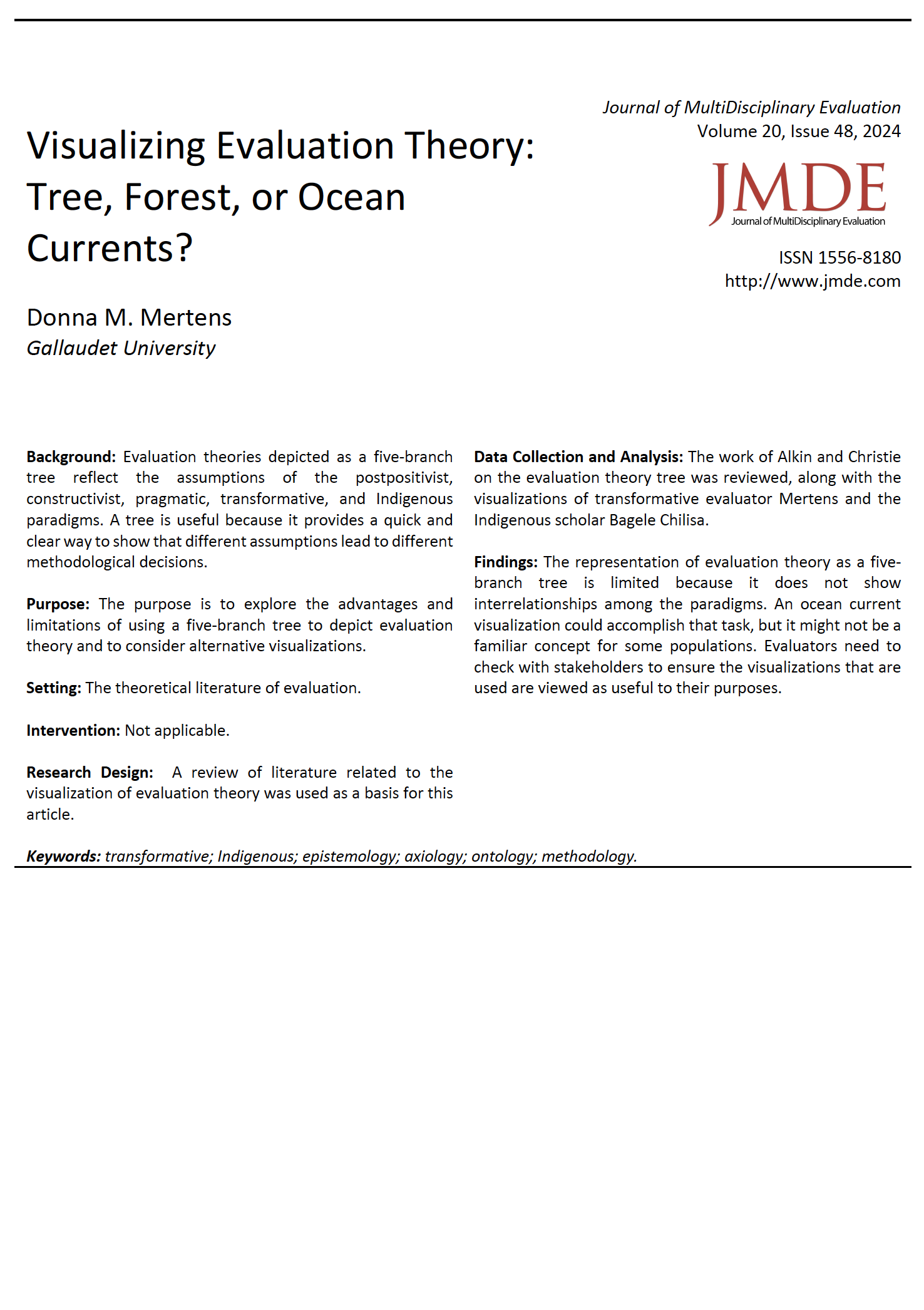Visualizing Evaluation Theory: Tree, Forest, or Ocean Currents?
Main Article Content
Abstract
Evaluation theories depicted as a five-branch tree reflect the assumptions of the post-positivist, constructivist, pragmatic, transformative, and Indigenous paradigms. A tree is useful because it provides a quick and clear way to show that different assumptions lead to different methodological assumptions. However, evaluation theory as a five-branch tree is limited because it does not show interrelationships between the paradigms. An ocean current visualization could accomplish that task, but it might not be a familiar concept for some populations. Evaluators need to check with stakeholders to ensure the visualizations that are used are viewed as useful to their purposes.
Downloads
Article Details

This work is licensed under a Creative Commons Attribution-NonCommercial 4.0 International License.
Copyright and Permissions
Authors retain full copyright for articles published in JMDE. JMDE publishes under a Creative Commons Attribution-NonCommercial 4.0 International License (CC BY - NC 4.0). Users are allowed to copy, distribute, and transmit the work in any medium or format for noncommercial purposes, provided that the original authors and source are credited accurately and appropriately. Only the original authors may distribute the article for commercial or compensatory purposes. To view a copy of this license, visit creativecommons.org
References
Alkin, M. (Ed.). (2004). Evaluation roots. Sage. https://doi.org/10.4135/9781412984157 DOI: https://doi.org/10.4135/9781412984157
Alkin, M., & Christie, C. (Eds.). (2023). Evaluation roots (3rd ed.). Sage.
Chilisa, B. (2020). Indigenous research methodologies (2nd ed.). Sage.
Chilisa, B., & Mertens, D. M. (2021). Indigenous Made in Africa evaluation frameworks: Addressing epistemic violence and contributing to social transformation. American Journal of Evaluation, 42(2), 241-253. https://doi.org/10.1177/1098214020948601 DOI: https://doi.org/10.1177/1098214020948601
Chouinard, J. A., & Cram, F. (2019). Culturally responsive approaches to evaluation. Sage.
Christie, C. A., & Alkin M. (2004). An evaluation theory tree. In M. Alkin (Ed.), Evaluation roots (pp. 12-66). Sage.
Cram, F., & Chouinard, J. A. (2023). Culturally responsive evaluation: An Indigenous journey through culturally responsive approaches. In M. Alkin & C. Christie (Eds.), Evaluation roots (3rd ed., pp. 145-157). Guilford Press.
Cram, F., & Mertens, D. M. (2015), Transformative and indigenous frameworks for multimethod and mixed methods research. In S. Hesse-Biber & R. B. Johnson (Eds.), The Oxford handbook of multimethod and mixed methods research inquiry (pp. 91-109). Oxford Press. https://doi.org/10.1093/oxfordhb/9780199933624.013.7 DOI: https://doi.org/10.1093/oxfordhb/9780199933624.013.7
Guba, E., & Lincoln, Y. S. (1989). Fourth generation evaluation. Sage.
Guba, E., & Lincoln, Y. S. (2005). Paradigmatic controversies, contradictions, and emerging confluences. In N. K. Denzin & Y. S. Lincoln (Eds.), Handbook of qualitative research (3rd ed., pp. 191-216). Sage.
Holder, E. & Xiong, C. (2022). Dispersion vs disparity: Hiding variables can encourage stereotyping when visualizing social outcomes. arXiv:2208.04440v2 [cs.HC] 25 Sep 2022 pp. 1-11. https://doi.org/10.1109/TVCG.2022.3209377 DOI: https://doi.org/10.1109/TVCG.2022.3209377
Mertens, D. M. (1998). Research and evaluation in education and psychology. Sage.
Mertens, D. M. (1999). Inclusive evaluation: Implications of transformative theory for evaluation. American Journal of Evaluation, 20(1), 1-14. https://doi.org/10.1177/109821409902000102 DOI: https://doi.org/10.1016/S1098-2140(99)80105-2
Mertens, D. M. (2018). Mixed methods design in evaluation. Sage. https://doi.org/10.4135/9781506330631 DOI: https://doi.org/10.4135/9781506330631
Mertens, D. M. (2023). The pursuit of social, economic, and environmental justice through evaluation: Learning from Indigenous scholars and the fifth branch of the evaluation theory tree. Journal of MultiDisciplinary Evaluation, 19(44), 11-23. https://doi.org/10.56645/jmde.v19i44.749 DOI: https://doi.org/10.56645/jmde.v19i44.749
Mertens, D. M. (2024). Research and evaluation in education and psychology (6th ed.). Sage.
Mertens, D. M., & Wilson, A. T. (2019). Program evaluation theory and practice (2nd ed.). Guilford Press.
Mertens, D.M., Hall, J. & Wilson, A.T. (in press). Program evaluation theory and practice. (3rd ed.) Guilford Press.
NOAA. (2023). What is the global ocean conveyor belt? https://oceanservice.noaa.gov/facts/conveyor.html
Rothstein, R. (2017). The color of law. NY: Liveright Publishing Corporation.
Schwabish, J. & Feng, A. (2021). Do no harm guide: Applying equity awareness in data visualization. Urban Institute. https://doi.org/10.31219/osf.io/x8tbw DOI: https://doi.org/10.31219/osf.io/x8tbw
United Nations. (2015, September 25). Resolution adopted by the general assembly: Transforming our world: The 2030 agenda for sustainable development.
Wohlleben, P. (2016). The Hidden life of trees. Greystone Books.

